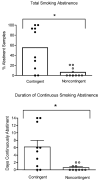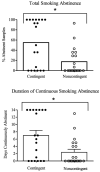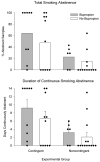Contingency management for behavior change: applications to promote brief smoking cessation among opioid-maintained patients
- PMID: 21341920
- PMCID: PMC3131670
- DOI: 10.1037/a0022039
Contingency management for behavior change: applications to promote brief smoking cessation among opioid-maintained patients
Abstract
Cigarette smoking is highly prevalent among patients who are being treated for opioid-dependence, yet there have been limited scientific efforts to promote smoking cessation in this population. Contingency management (CM) is a behavioral treatment that provides monetary incentives contingent upon biochemical evidence of drug abstinence. This paper discusses the results of two studies that utilized CM to promote brief smoking cessation among opioid-maintained patients. Participants in a pilot study were randomly assigned for a 2-week period to a Contingent group that earned monetary vouchers for providing biochemical samples that met criteria for smoking abstinence, or a Noncontingent group that earned monetary vouchers independent of smoking status (Dunn et al., 2008). Results showed Contingent participants provided significantly more smoking-negative samples than Noncontingent participants (55% vs. 5%, respectively). A second randomized trial that utilized the same 2-week intervention and provided access to the smoking cessation pharmacotherapy bupropion replicated the results of the pilot study (55% and 17% abstinence in Contingent and Noncontingent groups, respectively; Dunn et al, 2010). Relapse to illicit drug use was also evaluated prospectively and no association between smoking abstinence and relapse to illicit drug use was observed (Dunn et al., 2009). It will be important for future studies to evaluate participant characteristics that might predict better treatment outcome, to assess the contribution that pharmacotherapies might have alone or in combination with a CM intervention on smoking cessation and to evaluate methods for maintaining the abstinence that is achieved during this brief intervention for longer periods of time.
(c) 2011 APA, all rights reserved
Figures



Similar articles
-
Financial incentives to promote extended smoking abstinence in opioid-maintained patients: a randomized trial.Addiction. 2016 May;111(5):903-12. doi: 10.1111/add.13264. Epub 2016 Jan 23. Addiction. 2016. PMID: 26638126 Free PMC article. Clinical Trial.
-
A contingency-management intervention to promote initial smoking cessation among opioid-maintained patients.Exp Clin Psychopharmacol. 2010 Feb;18(1):37-50. doi: 10.1037/a0018649. Exp Clin Psychopharmacol. 2010. PMID: 20158293 Free PMC article. Clinical Trial.
-
Voucher-based contingent reinforcement of smoking abstinence among methadone-maintained patients: a pilot study.J Appl Behav Anal. 2008 Winter;41(4):527-38. doi: 10.1901/jaba.2008.41-527. J Appl Behav Anal. 2008. PMID: 19192857 Free PMC article. Clinical Trial.
-
Interventions to reduce tobacco use in people experiencing homelessness.Cochrane Database Syst Rev. 2020 Dec 3;12(12):CD013413. doi: 10.1002/14651858.CD013413.pub2. Cochrane Database Syst Rev. 2020. PMID: 33284989 Free PMC article.
-
Contingency Management for Patients Receiving Medication for Opioid Use Disorder: A Systematic Review and Meta-analysis.JAMA Psychiatry. 2021 Oct 1;78(10):1092-1102. doi: 10.1001/jamapsychiatry.2021.1969. JAMA Psychiatry. 2021. PMID: 34347030 Free PMC article.
Cited by
-
Interventions for tobacco smoking.Annu Rev Clin Psychol. 2013;9:675-702. doi: 10.1146/annurev-clinpsy-050212-185602. Epub 2013 Jan 3. Annu Rev Clin Psychol. 2013. PMID: 23297788 Free PMC article. Review.
-
The impact of behavioural risk reduction interventions on willingness to pay to avoid sexually transmitted infections: a stated preference study of justice-involved youth.Appl Econ. 2017;49(56):5673-5685. doi: 10.1080/00036846.2017.1332744. Epub 2017 Jun 5. Appl Econ. 2017. PMID: 32753764 Free PMC article.
-
Readiness to quit smoking and quit attempts among Australian mental health inpatients.Nicotine Tob Res. 2013 May;15(5):942-9. doi: 10.1093/ntr/nts206. Epub 2012 Oct 22. Nicotine Tob Res. 2013. PMID: 23089486 Free PMC article.
-
Financial Incentives for Smoking Abstinence in Homeless Smokers: A Pilot Randomized Controlled Trial.Nicotine Tob Res. 2018 Nov 15;20(12):1442-1450. doi: 10.1093/ntr/ntx178. Nicotine Tob Res. 2018. PMID: 29059442 Free PMC article. Clinical Trial.
-
Incentives for smoking cessation.Cochrane Database Syst Rev. 2025 Jan 13;1(1):CD004307. doi: 10.1002/14651858.CD004307.pub7. Cochrane Database Syst Rev. 2025. PMID: 39799985
References
-
- Bigelow GE, Stitzer ML, Griffiths RR, Liebson IA. Contingency management approached to drug self-administration and drug abuse: efficacy and limitations. Addictive Behaviors. 1981;6(3):241–252. - PubMed
-
- Bobo JK, Gilchrist LD, Schilling RF, Noach B, Schinke SP. Cigarette smoking cessation attempts by recovering alcoholics. Addictive Behaviors. 1987;12(3):209–215. - PubMed
-
- Bobo JK, Slade J, Hoffman AL. Nicotine addiction counseling for chemically dependent patients. Psychiatric Services. 1995;46(9):945–947. - PubMed
-
- Burling TA, Marshall GD, Seidner AL. Smoking cessation for substance abuse inpatients. Journal of Substance Abuse. 1991;3(3):269–276. - PubMed
-
- Burling TA, Ziff DC. Tobacco smoking: a comparison between alcohol and drug abuse inpatients. Addictive Behaviors. 1988;13(2):185–190. - PubMed
Publication types
MeSH terms
Substances
Grants and funding
LinkOut - more resources
Full Text Sources
Medical
Miscellaneous

